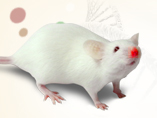

 Ever since the first published anecdotal reports of luminescent rhinaria on some members of the diminutive reindeer subspecies R. tarandus pearyi, the public and the scientific community alike have been fascinated striby thisking phenotype1-3. However, the biological basis for glowing reindeer noses has remained elusive until recently.
Ever since the first published anecdotal reports of luminescent rhinaria on some members of the diminutive reindeer subspecies R. tarandus pearyi, the public and the scientific community alike have been fascinated striby thisking phenotype1-3. However, the biological basis for glowing reindeer noses has remained elusive until recently.
The first major advance came in the late-1990s, when researchers formally described multiple pedigrees displaying cases of the red-nose phenotype4, followed quickly by applying linkage analysis in order to identify an associated genomic locus containing a single gene, termed Rud15. Inhibition of Rud1 expression using antisense approaches was shown to locally reduce nose brightness, but transgenic animals carrying the Rud1 red-nose allele did not display glowing noses, and instead had only weakly luminous tissues6.
The field of reindeer nose biology remained relatively stagnant until modern sequencing technology made the complete genome of north pole R. t. pearyi available, and in particular genome sequencing of several members of known red-nose families identified a second gene associated with rhinaria luminescence7. This second factor, termed RNAF (for Red-Nose Activating Factor) serves as an activation and localization cofactor for the RUD1 protein. Strikingly, transgenic mice carrying red-nose alleles of both Rud1 and Rnaf display brightly glowing noses, exactly like the natural red-nose reindeer phenotype8. This landmark discovery finally explains the genetic basis for the fascinating phenomenon of glowing reindeer noses, and has the potential to revolutionize the nascent field of illumination bioengineering.
Cyagen Biosciences provides custom mouse and rat model systems, including transgenics, knockouts and knockins, and CRISPR/Cas9 or TALEN genome editing, and our new TurboKnockout® gene targeted mice. However, we cannot make animal models carrying fictional or magical genes. VectorBuilder is our online vector design tool. You can design and order custom DNA constructs specific to your experimental needs. Choose from lentiviruses, AAV vectors, shRNA expression vectors, CRISPR/Cas9 vectors, and more!
* This article is meant to be humorous. All scientific information and entities described here are purely fiction.




영업일 기준 1-2일 내에 답변해 드리겠습니다.